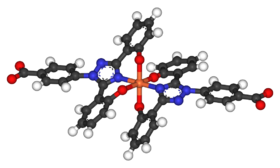
Iron chelation therapy

Chelation therapy is a medical procedure that involves the administration of chelating agents to remove heavy metals from the body. Chelation therapy has a long history of use in clinical toxicology and remains in use for some very specific medical treatments, although it is administered under very careful medical supervision due to various inherent risks.Occasionally adjunctive therapy in: Chelation therapy is a medical procedure that involves the administration of chelating agents to remove heavy metals from the body. Chelation therapy has a long history of use in clinical toxicology and remains in use for some very specific medical treatments, although it is administered under very careful medical supervision due to various inherent risks. Chelation therapy must be administered with care as it has a number of possible side effects, including death. In response to increasing use of chelation therapy as alternative medicine and in circumstances in which the therapy should not be used in conventional medicine, various health organizations have confirmed that medical evidence does not support the effectiveness of chelation therapy for any purpose other than the treatment of heavy metal poisoning. Over-the-counter chelation products are not approved for sale in the United States. Chelation therapy is the preferred medical treatment for metal poisoning, including acute mercury, iron (including in cases of sickle-cell disease and thalassemia), arsenic, lead, uranium, plutonium and other forms of toxic metal poisoning. The chelating agent may be administered intravenously, intramuscularly, or orally, depending on the agent and the type of poisoning. There are a variety of common chelating agents with differing affinities for different metals, physical characteristics, and biological mechanism of action. For the most common forms of heavy metal intoxication – lead, arsenic, or mercury – a number of chelating agents are available. Dimercaptosuccinic acid (DMSA) has been recommended for the treatment of lead poisoning in children by poison control centers around the world. Other chelating agents, such as 2,3-dimercaptopropanesulfonic acid (DMPS) and alpha lipoic acid (ALA), are used in conventional and alternative medicine. Some common chelating agents are ethylenediaminetetraacetic acid (EDTA), 2,3-dimercaptopropanesulfonic acid (DMPS), and thiamine tetrahydrofurfuryl disulfide (TTFD). Calcium-disodium EDTA and DMSA are only approved for the removal of lead by the Food and Drug Administration while DMPS and TTFD are not approved by the FDA. These drugs bind to heavy metals in the body and prevent them from binding to other agents. They are then excreted from the body. The chelating process also removes vital nutrients such as vitamins C and E, therefore these must be supplemented. The German Environmental Agency (Umweltbundesamt) listed DMSA and DMPS as the two most useful and safe chelating agents available. When used properly in response to a diagnosis of harm from metal toxicity, side effects of chelation therapy include dehydration, low blood calcium, harm to kidneys, increased enzymes as would be detected in liver function tests, allergic reactions, and lowered levels of dietary elements. When administered inappropriately, there are the additional risks of hypocalcaemia (low calcium levels), neurodevelopmental disorders, and death. Chelation therapy can be traced back to the early 1930s, when Ferdinand Munz, a German chemist working for I.G. Farben, first synthesized ethylenediaminetetraacetic acid (EDTA). Munz was looking for a replacement for citric acid as a water softener. Chelation therapy itself began during World War II when chemists at the University of Oxford searched for an antidote for lewisite, an arsenic-based chemical weapon. The chemists learned that EDTA was particularly effective in treating lead poisoning. Following World War II, chelation therapy was used to treat workers who had painted United States naval vessels with lead-based paints. In the 1950s, Norman Clarke, Sr. was treating workers at a battery factory for lead poisoning when he noticed that some of his patients had improved angina pectoris following chelation therapy. Clarke subsequently administered chelation therapy to patients with angina pectoris and other occlusive vascular disease and published his findings in The American Journal of the Medical Sciences in December 1956. He hypothesized that 'EDTA could dissolve disease-causing plaques in the coronary systems of human beings.' In a series of 283 patients treated by Clarke et al. From 1956-1960, 87% showed improvement in their symptomatology. Other early medical investigators made similar observations of EDTA's role in the treatment of cardiovascular disease (Bechtel, 1956; Bessman, 1957; Perry, 1961; Szekely, 1963; Wenig, 1958: and Wilder, 1962). In 1973, a group of practicing physicians created the Academy of Medical Preventics (now the American College for Advancement in Medicine). The academy trains and certifies physicians in the safe administration of chelation therapy. Members of the academy continued to use EDTA therapy for the treatment of vascular disease and developed safer administration protocols.
